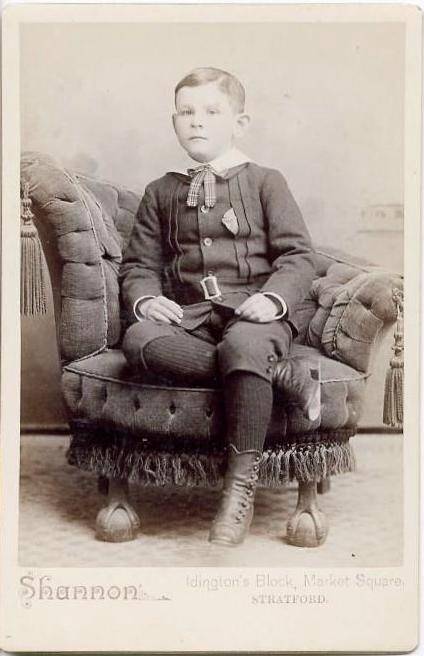
Photograpic Studio Mounts: Information

Figure 1.--The boy here is John Robert. The portrait was taken by Shannon, Idington's Block, Market Square, Stratford. The question is it Stratford in England, Canada (Ontario), or America (Connecticut). As the province or state is not indicated, we tend to believe the boy is English. Click on the image for a fuller discussion.
|
CDV and cabinent studio portraits in the 19th century which appeared in the 1860s almost always had information on the front and some had information on the back. The front normally had the name of the studio and the city, and sometimes the address on the front. Thus we usually know where the portraits were taken. There also was sometimes printing on the back providing more information on the studio. This might include prizes they have won. This seems more common in Europe than America. And as some are dated, the awards can assist in dating the images. One problem in using the information on the studio mounts is that the country is not normally specified. Normally we figure out the country, but there are some complications, especially with British and former colonies. This is because mamy towns in America, Canada, Australia, and New Zealand are named after British towns. The problem is complicated by ethnicity and clothing styles were similar. One helpful trend here is that American and Canadian studios mounts commonly added the state or province.
Front
CDV and cabinent studio portraits in the 19th century which appeared in the 1860s almost always had information on the front and some had information on the back. Some CDVs were blank. An example is a portrait of an unidentified girl. These were usually early CDVs, probably the 1860s. A few cabinent cards had information at the side, but this is almost always a horizontal format portrait. The front normally had the name of the studio and the city, and sometimes the address on the front. Thus we usually know where the portraits were taken. One problem in using the information on the studio mounts is that the country is not normally specified. Normally we figure out the country, but there are some complications, especially with British and former colonies. This is because mamy towns in America, Canada, Australia, and New Zealand are named after British towns. The problem is complicated by ethnicity and clothing styles were similar. One helpful trend here is that American and Canadian studios mounts commonly added the state or province.
Back
There also was sometimes printing on the back providing more information on the studio. This might include prizes they have won. This seems more common in Europe than America. And as some are dated, the awards can assist in dating the images.
HBC

Navigate the Boys' Historical Clothing Web Site:
[Return to:Main photographic studio mounts page]
[Return to:Main photographic page]
[Introduction]
[Activities]
[Biographies]
[Chronology]
[Clothing styles]
[Countries]
[Topics]
[Bibliographies]
[Contributions]
[FAQs]
[Glossaries]
[Satellite sites]
[Tools]
[Boys' Clothing Home]
Navigate the Boys' Historical Clothing Web Site:
[Sailor suits]
[Sailor hats]
[Buster Brown suits]
[Eton suits]
[Rompers]
[Tunics]
[Smocks]
[Pinafores]
Created: 10:59 PM 1/14/2006
Last updated: 11:00 PM 1/14/2006



